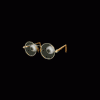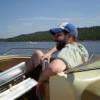 House of the temporarily dead http://www.guardian....1129295,00.html
House of the temporarily dead http://www.guardian....1129295,00.htmlIt sounds like science fiction gone mad - a fantastic edifice housing thousands of cryonically preserved bodies awaiting reanimation. But construction work on Stephen Valentine's creation, the Timeship, starts in two years. He talks to Steve Rose about the battle to conquer death
Friday January 23, 2004
The Guardian Woody Allen once remarked that he didn't want to achieve immortality through his work - he wanted to achieve it by not dying. Stephen Valentine could possibly do both. A self-professed visionary architect, Valentine has designed what could be the project of his career, and its purpose is to conquer death.
Officially, the building is "the world's first comprehensive facility devoted to life extension research and cryopreservation", a six-acre structure that will house research laboratories, animal and plant DNA, and up to 10,000 temporarily dead people. They will have paid to have their bodies (or perhaps just their heads) stored there until somebody works out a way to revive them. If Valentine is right, they won't have to wait too long. "This is going to be the century of immortality," he says. "Children being born today are probably going to live an average lifespan of 120 years. Their children, it is being predicted, will never die. There will be a time when people won't be able to comprehend the thought of not existing any more and just becoming fertiliser."
Cryonics, the practice of storing people at very low temperatures, has been commercially available since the 1970s. A handful of US firms currently charge around $120,000 (£65,000) for a full-body freeze (usually in liquid nitrogen), payable through the client's life insurance. Some 100 people, plus a few pets, are in their tanks, with several hundred more signed up. These "cryonauts" are effectively taking a double gamble - first that they will be faithfully preserved, and second that someone will find a way to bring them back to life in the future, either by repairing their whole body or - more likely - by transferring their consciousness into a fresh body (hence the need to store only their heads).
Nobody claims to have cracked human reanimation, but the first part of the process is just about viable, as long as a person is caught soon enough after death. The main problem is the damage caused by the freezing process when ice crystals form, destroying the body's cell structures. Cryonics companies say that by the time scientists have conquered death, they will also have the technology to repair damaged cells.
Given the nature of their activities, cryonics companies have typically operated from anonymous out-of-town warehouses but Valentine's Timeship is a significant departure: a dramatic, monumental building that will cost at least $250m (£135m) to build. Judging by the models in his New York studio, it will look like a cross between a fortress and a temple, rising out of Tuscan-landscaped gardens.
Within the perimeter wall, beneath research laboratories, will be 12 "neighbourhoods", each tightly packed with frozen bodies and heads (or neuros, as they are known). They are arranged around a central plaza, in the middle of which is a large tower in the shape of a truncated cone, representing a droplet of water, the stamen of a flower, and the phoenix - symbol of rebirth, Valentine explains. For a bit of sci-fi ambience, there will be a fine artificial mist drifting across the plaza, and angled mirrors around its edge will reflect the sky above.
"I've been able to integrate the symbolism and the architecture unlike anything ever been done before," says Valentine, a fast-talking, generously coiffed man in his late 40s, whose conviction frequently eclipses his modesty. He has spent a lifetime designing Utopian fantasies that are technically, if not financially, viable. These include creating floating cities for a man called Marshall T Savage, who had devised a plan to colonise the galaxy "in eight easy steps". Savage's wildly optimistic mission never got off the ground, but the self-sufficient ocean structures Valentine designed would probably have worked. Likewise his designs for buildings made out of water, or his floating countries, or his multi-billion dollar environmental theme park. But nobody had the funds to test them.
Timeship, though, is for real. The project is the brainchild of Saul Kent and Bill Falloon, two reclusive figures who have been involved in anti-ageing research since the 1960s. Together they formed the Life Extension Foundation, a Florida-based non-profit organisation involved in everything from selling vitamin supplements to investigating cures for cancer. Kent and Falloon have poured millions of dollars into (in Kent's words) "the kind of research favoured by those who hate growing old and dying, who love life deeply and want to see the fantastic world of the future."
Valentine first ran into Kent in 1990, at a cryonics meeting in New York, and Kent later asked him to come up with an initial concept for Timeship. He was given 10 weeks, and approached the task with a characteristic single-mindedness, researching everything from cosmic symbolism to ancient fortresses, glacial movements to nuclear blast scenarios. "I worked virtually around the clock. I didn't take a day off. I had the exact same meal, chicken noodle soup, every day because I couldn't afford to get sick."
He presented his scheme, and then heard nothing for three years. "It was like doing an audition for a play. They just said, 'OK, thanks,' and that was it. All the models went into storage in this huge warehouse. Remember the end of Raiders of the Lost Ark? It was like that."

Stephen Valentine
He later discovered the reason for the hold-up. Kent and Falloon had been creating a new company, 21st Century Medicine, headed by a leading cryobiologist called Greg Fahy. Fahy was working on a process called vitrification, by which organic materials take on glass-like properties when they are frozen, instead of forming damaging ice crystals. Such a breakthrough would revolutionise the world of organ transplants, and remove a major stumbling block of commercial cryonics.
With Fahy in place, Valentine's side of the project was reactivated in late 2000. Since then he has refined, tested and detailed Timeship's design, and has spent a long time looking for somewhere to build it. Considering the structure might have to last hundreds of years, resist all manner of natural and man-made disasters, and attract leading scientists and their families, the location was critical. Valentine is now negotiating for a piece of land "somewhere in the southern US". Construction will not begin for at least another two years.
In the meantime, he has effectively become spokesperson for the project, and, by extension, the cryonics industry in general. "Since the beginning of time we've done everything we can to make ourselves live longer. We've invented vaccines. We've cured diseases. What do we do that for? So people can live better and longer."
But shouldn't we be concentrating on increasing life expectancy for everybody, rather than increasing lifespan for a wealthy few? "Are we talking about a world where if I can find a way to make myself live longer, I should average it out and let everybody share my longevity? No. Can everybody afford to get a heart transplant? No. But a lot of things that were once not affordable are becoming affordable." But isn't the world going to get rather crowded if nobody ever dies? "First of all, we have a lot of space on this planet. Second, a lot of people might not want to live forever, and they can just die naturally."
Valentine also points out that Timeship will do more than just store temporarily dead people. It will also house the DNA of endangered species and organs for human transplants - a facility that could alter the face of healthcare. "It's a Fort Knox of biological materials, and it could be a Noah's Ark to the future."
Does Timeship ultimately represent selfish scientific folly or the logical conclusion of medicine? Valentine and company would rather cross that bridge when they come to it. In the meantime, they are busy building the bridge. Besides, as Valentine points out, the only people who will find out whether or not it was a good thing are those who sign up to it.
So does he have a berth on Timeship himself? "Not yet. I'm considering the idea. If I learned I had a few months to live I'd seriously consider it, but right now I'm not worried. I don't think I'm going to die soon."
























































